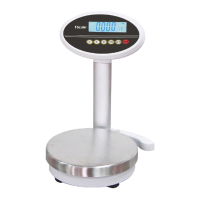ROW serial precision balance user’s manual
SECTION 6 OPERATION
6.1 Zeroing The Displa
You can press the ZERO key at any time to set the zero point from which all other
weighing and counting is measured, within 4% of power up zero. This will usually
only be necessary when the platform is empty. When the zero point is obtained the
display will show the indicator for zero.
The scale has an automatic rezeroing function to account for minor drifting or
accumulation of material on the platform. However you may need to press the ZERO
key to rezero the scale if small amounts of weight are shown when the platform is
empty.
6.2 Taring
Zero the scale by pressing the ZERO key if necessary. The zero indicator will be on.
Place a container on the platform, a value for its weight will be displayed.
Press the TARE key to tare the scale. The weight that was displayed is stored as the
tare value and that value is subtracted from the display, leaving zero on the display.
The "TARE" indicator will be on. As product is added only the weight of the product
will be shown. The scale could be tared a second time if another type of product was
to be added to the first one. Again only the weight that is added after taring will be
displayed.
When the container is removed a negative value will be shown. If the scale was tared
just before removing the container this value is the gross weight of the container plus
all product that was removed. The zero indicator will also be on because the platform
is back to the same condition it was when the ZERO key was last pressed.
6.3 Weighing a sample
To determine the weight of a sample first tare the empty container then place the
sample in the container. the display will show the weight and the units of weight
currently in use.
6.4 Check-Weighing
6.4.1 About check-weighing
Check-weighing is a procedure to cause an alarm to sound when the weight on the
scale meets or exceeds values stored in memory. The memory holds values for a
-6-

